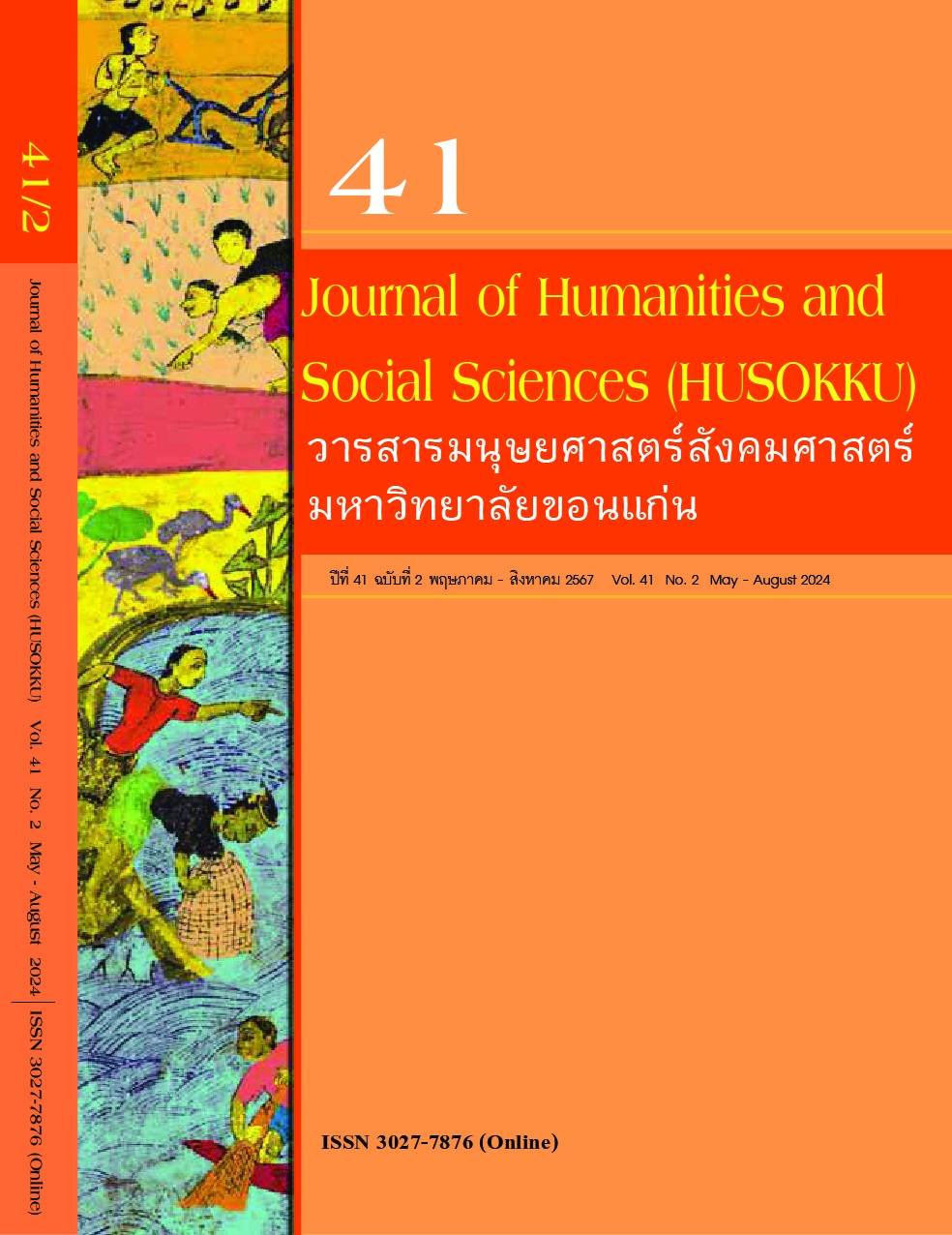การดำรงชีพของผู้สูงอายุอีสาน: มิติพื้นที่และปัจจัยกำหนด
Livelihoods of Isan Elderly People: Area Dimension and Determinants
Keywords:
livelihoods, self-esteem, access to capitals, elderlyAbstract
บทคัดย่อ
งานวิจัยนี้มุ่งศึกษาการดำรงชีพผู้สูงอายุ และปัจจัยกำหนดการดำรงชีพผู้สูงอายุภาคตะวันออกเฉียงเหนือ ประเทศไทย ใช้ระเบียบวิธีวิจัยเชิงปริมาณ มีหน่วยวิเคราะห์ระดับปัจเจกบุคคล เก็บรวบรวมข้อมูลเมื่อพฤศจิกายน-ธันวาคม 2561 ด้วยแบบสัมภาษณ์กับกลุ่มตัวอย่างผู้สูงอายุทั้งในเขตเมืองและเขตชนบท จังหวัดขอนแก่นและชัยภูมิ จำนวน 400 คน วิเคราะห์ข้อมูลด้วยสถิติพรรณนาและใช้สถิติถดถอยพหุคูณ เพื่อหาปัจจัยกำหนดการดำรงชีพผู้สูงอายุภาคตะวันออกเฉียงเหนือ ผลการวิจัยพบว่า ผู้สูงอายุมีการดำรงชีพในภาพรวม ซึ่งเป็นผลรวมจากคะแนนวิถีการดำรงชีพของผู้สูงอายุใน 5 ลักษณะ คือ การดิ้นรนต่อสู้ในการดำรงชีพ การสร้างทางเลือกในการดำรงชีพ การหาวิธีแก้ไขปัญหาในการดำรงชีพ การอยู่รอดเพื่อการดำรงชีพ และความยั่งยืนในการดำรงชีพ ซึ่งทั้งผู้สูงอายุในพื้นที่เมืองและชนบทส่วนใหญ่มีระดับการดำรงชีพอยู่ในระดับปานกลาง ร้อยละ 60.6 และ 62.7 ตามลำดับ เมื่อพิจารณารายด้าน พบว่า ผู้สูงอายุส่วนใหญ่มีการดำรงชีพด้านการสร้างทางเลือก ด้านการหาวิธีแก้ไขปัญหา และด้านการอยู่รอด อยู่ในระดับปานกลาง คิดเป็นร้อยละ 47.7, 58.8 และ 62.4 ตามลำดับ ในขณะที่ด้านการดิ้นรนต่อสู้ กว่า 1 ใน 2 ของผู้สูงอายุมีระดับการดำรงชีพอยู่ในระดับต่ำ และเป็นที่น่าสังเกตว่ากว่า 2 ใน 3 ของผู้สูงอายุกลับมีการดำรงชีพด้านความยั่งยืนในระดับสูง โดยผู้สูงอายุมีวิถีการดำรงชีพรายด้านเป็นแบบแผนเดียวกันทั้งในพื้นที่เมืองและชนบท เมื่อวิเคราะห์ปัจจัยกำหนดการดำรงชีพของผู้สูงอายุ พบว่า อายุ การเห็นคุณค่าในตนเอง ความสัมพันธ์กับคนในครอบครัว การเข้าถึงทุนการเงิน การเข้าถึงทุนมนุษย์ และการเข้าถึงทุนสังคม เป็นปัจจัยกำหนดการดำรงชีพผู้สูงอายุภาคตะวันออกเฉียงเหนือ ทั้งในเขตเมืองและชนบท อย่างมีนัยสำคัญทางสถิติที่ระดับ 0.05 ซึ่งเป็นไปตามสมมติฐานการวิจัยที่ตั้งไว้ โดยตัวแปรอิสระร่วมกันอธิบายการผันแปรของการดำรงชีพของผู้สูงอายุร้อยละ 47.2 (R2=0.472)
คำสำคัญ: การดำรงชีพ, การเห็นคุณค่าในตนเอง, การเข้าถึงทุน, ผู้สูงอายุ
References
กระทรวงการพัฒนาสังคมและความมั่นคงของมนุษย์. (2552). โครงการเบี้ยผู้สูงอายุหรือโครงการสร้างหลักประกันด้านรายได้แก่ผู้สูงอายุ. กรุงเทพฯ : กระทรวงการพัฒนาสังคมและความมั่นคงของมนุษย์.
กระทรวงการพัฒนาสังคมและความมั่นคงของมนุษย์. (2553). การจ่ายเบี้ยคนพิการ. กรุงเทพฯ : กระทรวงการพัฒนาสังคมและความมั่นคงของมนุษย์.
ดุษฎี อายุวัฒน์, อภิรดี วงศ์ศิริ, ปณัทพร เรืองเชิงชุม, สุวิมล คำน้อย และณัฐวรรธ อุไรอำไพ. (2566). การสะสมทุนสังคมในถิ่นปลายทางของแรงงานอีสานย้ายถิ่นกลับจากต่างประเทศ. วารสารภาษา ศาสนา และวัฒนธรรม, 12(2), 114-139.
มูลนิธิสถาบันวิจัยและพัฒนาผู้สูงอายุไทย. (2565). สถานการณ์ผู้สูงอายุไทย พ.ศ. 2565. กรุงเทพฯ: อมรินทร์ คอร์เปอเรชั่นส์.
ระบบสถิติทางการลงทะเบียน กรมการปกครอง. (2560). รายงานผลเบื้องต้นสำรวจประชากรสูงอายุในประเทศไทย พ.ศ. 2560. (ออนไลน์). สืบค้นเมื่อ 20 ตุลาคม 2565, จาก
https://www.m-society.go.th/article_attach/14494/18145.pdf.
รักชนก ชำนาญมาก และคณะ. (2561). องค์ประกอบความสุขของผู้สูงอายุในชนบทภาคตะวันออกเฉียงเหนือ: พลวัตการเปลี่ยนแปลงทางสังคมในกระแสโลกาภิวัตน์. วารสารมนุษยศาสตร์ สังคมศาสตร์, 35(2) ,90-116.
ศศิพัฒน์ ยอดเพชร. (2559). ครอบครัวและผู้สูงอายุ. ใน ชื่นตา วิชชาวุธ (บรรณาธิการ), การทบทวนและสังเคราะห์องค์ความรู้ผู้สูงอายุไทย พ.ศ. 2545-2550. แผนงานวิจัยเพื่อพัฒนาคุณภาพชีวิตที่ดีของผู้สูงอายุ สถาบันวิจัยระบบสาธารณสุข (สวรส.) มูลนิธิสถาบันวิจัยและพัฒนาผู้สูงอายุไทย (มส.ผส.).
สำนักงานสถิติแห่งชาติ. (2561). การทำงานของผู้สูงอายุในประเทศไทย. กรุงเทพฯ: สำนักงานสถิติแห่งชาติ.
สำนักงานสถิติแห่งชาติ. (2566). ข้อมูลสถิติจำนวนผู้สูงอายุประเทศไทย ปี 2565. กรุงเทพฯ: สำนักงานสถิติแห่งชาติ.
อิทธิพงษ์ ทองศรีเกตุ ดุษฎี อายุวัฒน์ และเสาวลักษณ์ ชายทวีป. (2560). การย้ายถิ่นในกลุ่มผู้สูงอายุ : การเปลี่ยนแปลงชีวิตจากชนบทเข้าสู่เมือง. วารสารสังคมศาสตร์, 29(2), 103-134.
สำนักงานสถิติแห่งชาติ. (2557). รายงานผลเบื้องต้นสำรวจประชากรสูงอายุในประเทศไทย พ.ศ.2557. (ออนไลน์). สืบค้นเมื่อ 20 ตุลาคม 2560, จาก
https://www.m-society.go.th/article_attach/14494/18145.pdf.
Auraiampai, N., Ayuwat, D., Jampaklay, A. and Onaka, F. (2023). Entrepreneurial Processes of Thai Female Returning Migrants. Comparative Sociology, 22(5), 717-739.
Chambers, R. and Conway, G.R. (1991). Ideas for Development. London: Earthscan.
Chambers, R. (2005). Chapter 4: Critical Reflections of a Development Nomad, in A Radical History of Development Studies: Individuals, Institutions and Ideologies. Kothari, U. (ed.). London: Zed Books.
Chyi, H. and Mao, S. (2021). The Determinants of Happiness of China’s Elderly Population. Journal of Happiness Studies, 22(1), 167-185.
Conway, G. (2022). Revolutionizing Development. New York: Routledge.
David, B. (1991). Conditioning Diagnostics: Collinearity and Weak Data in Regression. New York: Wiley.
DFID. (1999). Sustainable Livelihoods Guidance Sheets. London: Department for International Development (DFID).
Ergin, I. and Mandiracioglu, A. (2015). Demographic and socioeconomic inequalities for self-rated health and happiness in elderly: The situation for Turkey regarding World Values Survey between 1990 and 2013. Archives of Gerontology and Geriatrics, 61(2), 224-230.
Gyawali, S., Tiwari, S.R. and Bajacharya,. S.B. (2020). Promoting sustainable livelihoods: An approach to postdisaster reconstruction. Sustainable Development, 28(4), 626-633.
Hong-ngam, J., et al. (2021). Factors affecting the level of happiness through economics status: Evidences from elderly in the northeastern region of Thailand. International Journal of Business and Globalisation, 29(1), 116-134
Kim, T., Choi, S.D. and Xiong, S. (2020). Epidemiology of fall and its socioeconomic risk factors in community-dwelling Korean elderly. PLOS ONE, 15(6): e0234787. https://doi.org/10.1371/journal.pone.0234787
Long, H.L. et al. (2010). Building New Countryside in China: a Geographical Perspective. Land Use Policy, 27(2), 457-470.
Luchesi, H., et al. (2018). Factors associated with happiness in the elderly persons living in the community. Archives of Gerontology and Geriatrics, 74(2), 83-87.
Menec, V.H. et al. (2020). Examining social isolation and loneliness in combination in relation to social support and psychological distress using Canadian Longitudinal Study of Aging (CLSA) data. PLOS ONE, 15(3): e0230673. https://doi.org/10.1371/journal.pone.0230673
Moeini, B., Barati, M., Farhadian, M., Babamiri, M., Heydari, M., et al. Happiness and Its Related Factors among the Elderly in Hamadan (Iran): A Cross Sectional Study. Avicenna J Neuro Psycho Physiology, 3(4): e57782.
Moser, C. (2006). Assets, Livelihoods, and Social Policy. Washington, DC: The world Bank.
Narongchai, W., Ayuwat, D. and Chinnasri, O. (2016). The changing of intergenerational transfers of economic capital in rural households in Northeastern, Thailand. Kasetsart Journal of Social Sciences, 37(1), 46-52.
Natarajan, N., Newsham, A., Rigg, J. and Suhardiman, D. (2022). A sustainable livelihoods framework for the 21st century. World Development, 155(1), 105898.
Prasongthan, S., Thanandornsuk, K. and Charoenbunprasert, S. (2021). Thai Senior tourists: Explore of Travel Constraints, Recreational Activities and Travel Intention. Social Sciences Journal, 10(1), 119-131.
Rahman, M.M. and Akter, S. (2010). The determinants of early cessation of breastfeeding in Bangladesh. World Health Population, 11(4), 5-12.
Rogers, A and Vertovec, S. (2020). The Urban Context: Ethnicity, Social Networks and Situational Analysis. New York: Routledge.
Sailo, L. (2022). Well-being of the elderly Mizos as a function of social participation, family relations and stress. Mizoram: Mizoram University,
Tambe, S. (2022). Sustainable Livelihoods Approach. In: Teaching and Learning Rural Livelihoods. Sustainable Development Goals Series. Springer, Cham. https://doi.org/10.1007/978-3-030-90491-3_4
Thipprakmas, R. (2021). Social Protective Factors in Depression among the Elderly: The Role of Family, Social and Community Supports. Regional Health Promotion Center 9 Journal, 15(37), 339-351.
Thongsrikate, I., Ayuwat, D. and Chaytaweep, S. (2019). A qualitative study on social integration of elderly migrants moving into urban areas. International Journal of Interdisciplinary Social and Community Studies, 14(1), 1-12.
Yamane, T. (1973). Statistics: an introductory analysis. New York: New York: Harper. & Row.
Yeom, H., Jung, M. and Park, E. (2020). The Relationship Between Social Support, Aging Expectations, and Health Behavior in Middle Age. Innov Aging, 4(1), 409-429.
Xiang, C. et al. (2017). Relationship between psychological capital and life quality in elderly people. Western Pacific Region Index Medicus, 31(9), 718-722.



